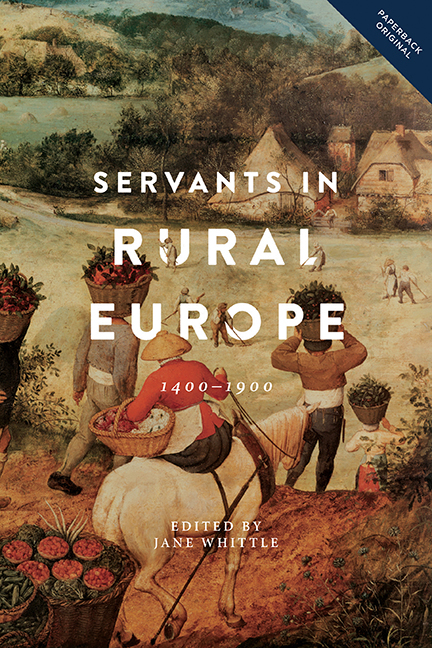Book contents
- Frontmatter
- Contents
- List of Figures
- List of Tables
- Note on Terminology
- List of Contributors
- Introduction: Servants in the Economy and Society of Rural Europe
- 1 The Employment of Servants in Fifteenth- and Sixteenth-Century Coastal Flanders: A Case Study of Scueringhe Farm near Bruges
- 2 The Institution of Service in Rural Flanders in the Sixteenth Century: A Regional Perspective
- 3 A Different Pattern of Employment: Servants in Rural England c.1500–1660
- 4 Female Service and the Village Community in South-West England 1550–1650: The Labour Laws Reconsidered
- 5 Life-Cycle Servant and Servant for Life: Work and Prospects in Rural Sweden c.1670–1730
- 6 Servants in Rural Norway c.1650–1800
- 7 Rural Servants in Eighteenth-Century Münsterland, North- Western Germany: Households, Families and Servants in the Countryside
- 8 Rural Servants in Eastern France 1700–1872: Change and Continuity Over Two Centuries
- 9 The Servant Institution During the Swedish Agrarian Revolution: The Political Economy of Subservience
- 10 Farm Service and Hiring Practices in Mid-Nineteenth-Century England: The Doncaster Region in the West Riding of Yorkshire
- 11 Dutch Live-In Farm Servants in the Long Nineteenth Century: The Decline of the Life-Cycle Service System for the Rural Lower Class
- 12 Rural Life-Cycle Service: Established Interpretations and New (Surprising) Data – The Italian Case in Comparative Perspective (Sixteenth to Twentieth Centuries)
- Select Bibliography
- Index
- People, Markets, Goods: Economies and Societies in History
6 - Servants in Rural Norway c.1650–1800
Published online by Cambridge University Press: 18 April 2018
- Frontmatter
- Contents
- List of Figures
- List of Tables
- Note on Terminology
- List of Contributors
- Introduction: Servants in the Economy and Society of Rural Europe
- 1 The Employment of Servants in Fifteenth- and Sixteenth-Century Coastal Flanders: A Case Study of Scueringhe Farm near Bruges
- 2 The Institution of Service in Rural Flanders in the Sixteenth Century: A Regional Perspective
- 3 A Different Pattern of Employment: Servants in Rural England c.1500–1660
- 4 Female Service and the Village Community in South-West England 1550–1650: The Labour Laws Reconsidered
- 5 Life-Cycle Servant and Servant for Life: Work and Prospects in Rural Sweden c.1670–1730
- 6 Servants in Rural Norway c.1650–1800
- 7 Rural Servants in Eighteenth-Century Münsterland, North- Western Germany: Households, Families and Servants in the Countryside
- 8 Rural Servants in Eastern France 1700–1872: Change and Continuity Over Two Centuries
- 9 The Servant Institution During the Swedish Agrarian Revolution: The Political Economy of Subservience
- 10 Farm Service and Hiring Practices in Mid-Nineteenth-Century England: The Doncaster Region in the West Riding of Yorkshire
- 11 Dutch Live-In Farm Servants in the Long Nineteenth Century: The Decline of the Life-Cycle Service System for the Rural Lower Class
- 12 Rural Life-Cycle Service: Established Interpretations and New (Surprising) Data – The Italian Case in Comparative Perspective (Sixteenth to Twentieth Centuries)
- Select Bibliography
- Index
- People, Markets, Goods: Economies and Societies in History
Summary
In the summer of 1799, demographer Thomas R. Malthus toured Scandinavia spending almost six weeks in Norway. On his way north to Trondheim, he stopped at an inn and found seven men in the kitchen eating ‘a most comfortable breakfast, of fried bacon & veal, some fried fish, large bowls of milk, & oat cake & butter’. Malthus was not sure what the men actually did, but the innkeeper confirmed they were his men and ‘lived in his house’. None were married. Based on this, Malthus concluded that the men were servants, and went on to argue that
[t]he establishments of farmers in this country [Norway] appear to be much larger than with us, and it is probable that the sons of housemen & small farmers become the servants of farmers, and do not marry till they are able to obtain a houseman's place.
What Malthus described, despite exaggerating the difference between England and Norway, is what Peter Laslett later came to call life-cycle service: service as a temporary position for young, unmarried people who circulated between households until they married and established households of their own.
This chapter examines the institution of service in rural Norway from the middle of the seventeenth century to the end of the eighteenth century. In this period, the amount and type of source material increased substantially compared with the previous centuries, which makes it possible to examine the size and make-up of the servant population. The chapter particularly deals with the varied experience of service, and looks at regional and local differences.
Since the 1960s, research on census data and parish registers has largely confirmed that servants in pre-industrial Norway fit Malthus’ description: servants were young, unmarried and lived in the same household as their employers. At the same time, Norwegian population data and information on the servant institution have been used to argue that households in north-west Europe differed from households elsewhere. In his famous ‘Two Kinds of Preindustrial Household Formation System’, John Hajnal used census data from three areas in Norway in 1801, together with data from other countries in north-western Europe, to argue that a particular kind of household system where people married late and set up independent households upon marriage existed in north-western Europe in the pre-industrial period.
- Type
- Chapter
- Information
- Servants in Rural Europe1400–1900, pp. 113 - 130Publisher: Boydell & BrewerPrint publication year: 2017

